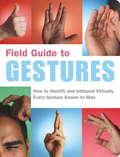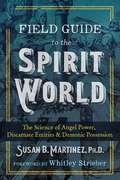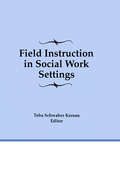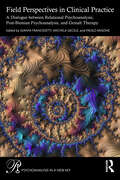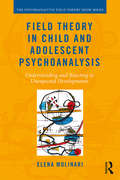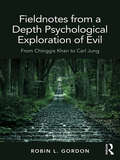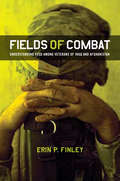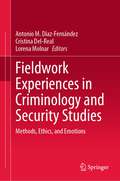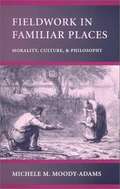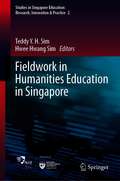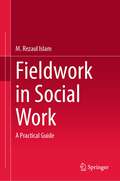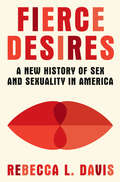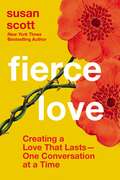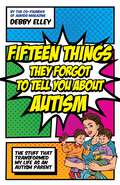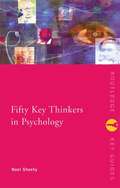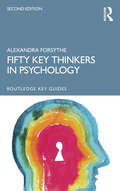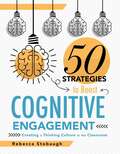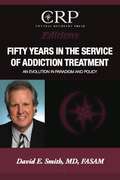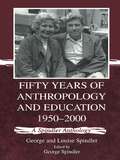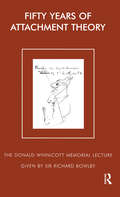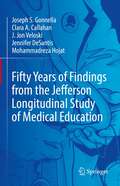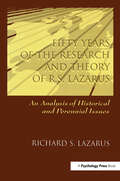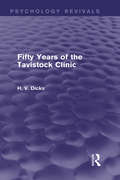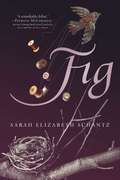- Table View
- List View
Field Guide to Gestures
by Nancy Armstrong Melissa WagnerFinally, a field guide to interpreting more than 100 international gestures, from the wave to the finger, from the shrug to the nod. Here's easy access to the essential information about common (and some not-so-common) gestures you may encounter at home or abroad. Field Guide to Gestures is organized into handy sections for quick reference when time is of the essence and interpretation is everything. If a man bends his torso forward when meeting you, turn to the "Arrival/Departure" chapter to learn more about the bowing gesture. When the woman at the end of the bar flips her hair and looks your way, turn to the "Mating" chapter to learn just what she's trying to say. And if your friend has intertwined his index finger and middle fingers as the night's lottery numbers are being read, go to "No Words Needed" to learn more about the crossed fingers gesture. This practical guide includes more than 100 full-color photographs of the world's most common gestures, plus cross-referenced descriptions throughout, including historical background and common usage. Helpful step-by-step directions and detailed line drawings teach you how to perform each gesture correctly.
Field Guide to the Spirit World: The Science of Angel Power, Discarnate Entities, and Demonic Possession
by Susan B. MartinezA comprehensive examination of the many ways the spirit world affects the material plane and our minds • Provides a detailed guide to the Afterlife and its inhabitants • Reveals the spirit influence behind many mental disorders as well as psi abilities and creative genius • Includes checklists of symptoms of spirit “overshadowing,” methods from the world’s top exorcists, and instructions on how to free unwanted spirits from the material plane We are spirits housed in a body, and just as houses can be haunted, so can people. When the living succumb to dissociative states of consciousness, they become a magnet for lost but clinging spirits. Known as jinn, dybbuk, daemon, wuqabi, or simply the undead, they hover unseen on the earth plane, ready to inhabit the most suitable body available. Documenting the life of wandering spirits and their impact on vulnerable human targets, Susan Martinez offers a radical departure from the standard psychological explanations for a host of pathological behaviors--including multiple personality, autism, epilepsy, migraines, obsessive compulsive disorder, depression, schizophrenia, anxiety, PTSD, self-destructive urges, and strange outbursts--and reveals that hallucinations are often true impressions of spirit input. Martinez explains how mental health comes down to the delicate balance between self-control and spirit-control. When trauma triggers an escape response, the soul takes flight, leaving the mind susceptible to possession by discarnate entities. However, the spirit world can also bestow gifts upon those whose psyches are open, such as in the case of mediums, shamans, people who communicate with angels, and many of the world’s creative geniuses. Martinez presents “overshadowing” by spirits as a universal, cross-cultural phenomenon, documenting modern and traditional accounts as well as corroborating indigenous beliefs. She examines soul decay, soul travel both before and after death, as well as how knowledge of the spirit world can offer positive treatments for disorders like schizophrenia and autism. Providing a detailed guide to the spirit world and its inhabitants, the author offers checklists of symptoms of “overshadowing,” methods from the world’s top exorcists, and instructions on how to free spirits so they can continue their journey into the beyond--all the tools necessary to forearm us against soul snatchers and other enemies of the Light.
Field Instruction in Social Work Settings
by Toba Schwaber KersonField Instruction in Social Work Settings explores the relationship between field instruction and the setting in which it occurs. The book asserts that certain aspects of social work, including laws, funding, political climate, organizational policies, and values, affect the relationship between student and field instructor and shape teaching and learning. The book explores dimensions of the student/field instructor relationship such as goals and expectations, development of professional identity, uses of the self, issues of diversity, authority, dependency, autonomy, value dilemmas, and the structure of supervision. It presents a framework for teaching field instruction and uses the framework to explore its relevance, meaning, and use in the following settings: perinatal AIDS program public child welfare child advocacy agency public school occupational health and safety project family service psychiatric hospital case management program for the elderly day center for the elderlyField Instruction in Social Work Settings is the only book available relating field instruction to the specific context in which it occurs. It recognizes the social work field’s diminished budget and increased demands and points out the critical necessity of students learning to address and manage policy and organizational issues as they develop their social work skills. This book is an aid to field instructors balancing increases in enrollment and curriculum content and decreases in placements and budgets. It integrates all of these concerns with field practice and seeks to provide a model for those working in the field as instructors and students. Field Instruction in Social Work Settings applies classroom material to social work settings and emphasizes the value of field instruction by relating it to the branches of child welfare, mental health, and health care. It allows the reader to integrate social work policy and advocacy with field work, and it provides the reader with an appreciation of how social work and field instruction can work together directly.
Field Perspectives in Clinical Practice: A Dialogue between Relational Psychoanalysis, Post-Bionian Psychoanalysis, and Gestalt Therapy (Psychoanalysis in a New Key Book Series)
by Michela Gecele Gianni Francesetti Paolo MigoneThis book is the outcome of fruitful engagement between relational psychoanalysis, neo-Bionian psychoanalysis, and Gestalt therapy on a contemporary growing edge of clinical practice: field theory.What is happening in contemporary clinical practice that seems to be pushing theories towards a field perspective? Clinical issues are complex phenomena—they cannot be separated from social and cultural changes. Suffering, clients, and therapists change over time, and with them so do the needs and theoretical approaches of clinical professionals, so as to be able to update and adjust care practices.This book is an independent, yet common study, which through the field concept explores what complexity theories and dynamic systems theories have described as “emerging phenomena,” or what phenomenological philosophy categorized as phenomenal field, pathic aesthetics, and atmospherology, or, more generally, our understanding of the relationship between clinical practice and critical thinking and of the centrality of the individual, as developed by postmodern thinkers.With multiple professional perspectives and essential clinical material, this is key reading for psychoanalysts and psychotherapists.
Field Theory in Child and Adolescent Psychoanalysis: Understanding and Reacting to Unexpected Developments (Psychoanalytic Field Theory Book Series)
by Elena MolinariField Theory in Child and Adolescent Psychoanalysis looks at the intersection of two types of psychoanalysis that challenge the classic model; child analysis, and field theory. Children impose a faster pace on the analysis and a much less stable structure than adults, whilst psychoanalytic field theory looks at the patient-analyst relationship in a much wider context than is typical. By combining these two approaches, this book advocates the use of a set of tools and techniques that allow the psychoanalyst to understand and react much faster than normal, and to be better prepared for unexpected developments. This book shows the reader how to navigate smoothly and steadily through passages of tense analytical situations, which might otherwise feel like being trapped in a maze with no obvious way out. Bion's writings allowed the improvement of new techniques or instruments for exploring the psychoanalytical process. Discussion about technique is a hugely important and necessary step for improving the evidence base of psychoanalytic psychotherapy. This book also seeks to improve the research in therapeutic effectiveness and unexpected relations between body and mind, emotions and dreams. By doing so, Elena Molinari contributes to expanding the perspectives that child and adolescent psychoanalysts have had in exploring primitive functioning of the mind. With specific emphasis on working with difficult situations and patients, Field Theory in Child and Adolescent Psychoanalysis is a highly practical book that will appeal greatly to child psychoanalysts and psychoanalytic psychotherapists, as well as psychologists, paediatricians and advanced students studying across these fields.
Fieldnotes from a Depth Psychological Exploration of Evil: From Chinggis Khan to Carl Jung
by Robin L. GordonIn Fieldnotes from a Depth Psychological Exploration of Evil, Robin L. Gordon presents an accessible account of an attempt to define and understand the nature of evil. Gordon takes on the role of guide to this confusing land, tying together threads of Jungian theory, philosophy, etymology, neuroscience and history, as we are led on a personal journey of discovery. Gordon begins by analysing what a twelfth-century meeting between Chinggis Khan and Taoist priest Ch’ang-Ch’un can tell us about the presence of opposing traits and the nature of evil in human beings. We learn what depth psychology has said about evil and the shadow part of our psyches, and examine examples of human behaviour throughout history to understand the etymological, philosophical and historical understandings and definitions of evil. Gordon’s own relationship with her work, and the feelings that arise when researching the psychological framework of Nazi doctors, genocide in Rwanda, Bosnia and Syria, and the functionality of serial killers, are interrogated. We then return to Chinggis Khan’s and Ch’ang-Ch’un’s relationship, attempting to build a real and practical definition of "evil", and assessing their dialogues as a metaphor for Jung’s views of the transcendent function. Fieldnotes from a Depth Psychological Exploration of Evil will be essential reading for academics and students of Jungian and post-Jungian studies, sociology, criminology and philosophy. It will also be a key resource for Jungian analysts and psychotherapists interested in the study of evil and its impact on society and the psyche, as well as anyone investigating and redefining their own meanings of evil, past and present.
Fields of Combat: Understanding PTSD among Veterans of Iraq and Afghanistan (The Culture and Politics of Health Care Work)
by Erin P. Finley"If you consider Iraq—like I do, probably twenty-nine out of thirty days—to be the pinnacle of your life, then where do you go from there? And I'm sure that a lot of veterans feel that way. To them, that was it. That was everything. So now what? They have to find something meaningful and purposeful.""When I got back from Afghanistan, there was not even so much as a briefing that said, 'Let us know if you're having problems.' There wasn't so much as a phone number. There was literally nothing.""I knew it was crazy. I was thinking, the guy on the roof's either a sniper or he's going to radio ahead. And then I thought, this is San Antonio. There's not snipers on the roof, nobody's going to blow me up here.""Whenever I look at people back here at home, I know what they're going to look like dead. I know what they look like with their brains blown out or jaws blown off or eyes pulled out. When I look at somebody I see that, to this day."—Voices of veterans interviewed in Fields of CombatFor many of the 1.6 million U.S. service members who have served in Iraq and Afghanistan since 2001, the trip home is only the beginning of a longer journey. Many undergo an awkward period of readjustment to civilian life after long deployments. Some veterans may find themselves drinking too much, unable to sleep or waking from unspeakable dreams, lashing out at friends and loved ones. Over time, some will struggle so profoundly that they eventually are diagnosed with post-traumatic stress Disorder (PTSD).Both heartbreaking and hopeful, Fields of Combat tells the story of how American veterans and their families navigate the return home. Following a group of veterans and their personal stories of war, trauma, and recovery, Erin P. Finley illustrates the devastating impact PTSD can have on veterans and their families. Finley sensitively explores issues of substance abuse, failed relationships, domestic violence, and even suicide and also challenges popular ideas of PTSD as incurable and permanently debilitating. Drawing on rich, often searing ethnographic material, Finley examines the cultural, political, and historical influences that shape individual experiences of PTSD and how its sufferers are perceived by the military, medical personnel, and society at large. Despite widespread media coverage and public controversy over the military's response to wounded and traumatized service members, debate continues over how best to provide treatment and compensation for service-related disabilities. Meanwhile, new and highly effective treatments are revolutionizing how the Department of Veterans Affairs (VA) provides trauma care, redefining the way PTSD itself is understood in the process. Carefully and compassionately untangling each of these conflicts, Fields of Combat reveals the very real implications they have for veterans living with PTSD and offers recommendations to improve how we care for this vulnerable but resilient population.
Fieldwork Experiences in Criminology and Security Studies: Methods, Ethics, and Emotions
by Antonio M. Díaz-Fernández Cristina Del-Real Lorena MolnarThis book compiles the fieldwork experiences of 55 researchers, addressing the challenges, ethical considerations, and methodologies employed to study 30 diverse populations and phenomena within Criminology and Security Studies. This volume contributes to filling a gap in academic literature by highlighting the often unspoken realities and intricacies of fieldwork. The book is systematically structured into five thematic sections: The Powerful, The Invisible, The Vulnerable, The Violent, and The Cyber. These categories encompass various aspects and dimensions of fieldwork, including managing emotional distress, negotiating access through gatekeepers, ensuring the protection of informants, and exercising discretion in navigating sensitive issues. As a scholarly resource, this book is invaluable for academics, practitioners, and students involved in criminology, security studies, anthropology, sociology, and political science. By offering in-depth reflections and insights, this volume enhances the reader’s understanding of the nuances of fieldwork, and informs the development of robust and ethical research practices.Chapters 2, 9 and 11 are available open access under a Creative Commons Attribution 4.0 International License via link.springer.com.
Fieldwork In Familiar Places: Morality, Culture, And Philosophy
by Michele M. Moody-AdamsThe persistence of deep moral disagreements--across cultures as well as within them--has created widespread skepticism about the objectivity of morality. Moral relativism, moral pessimism, and the denigration of ethics in comparison with science are the results. Fieldwork in Familiar Places challenges the misconceptions about morality, culture, and objectivity that support these skepticisms, to show that we can take moral disagreement seriously and yet retain our aspirations for moral objectivity. Michele Moody-Adams critically scrutinizes the anthropological evidence commonly used to support moral relativism. Drawing on extensive knowledge of the relevant anthropological literature, she dismantles the mystical conceptions of "culture" that underwrite relativism. She demonstrates that cultures are not hermetically sealed from each other, but are rather the product of eclectic mixtures and borrowings rich with contradictions and possibilities for change. The internal complexity of cultures is not only crucial for cultural survival, but will always thwart relativist efforts to confine moral judgments to a single culture. Fieldwork in Familiar Places will forever change the way we think about relativism: anthropologists, psychologists, historians, and philosophers alike will be forced to reconsider many of their theoretical presuppositions. Moody-Adams also challenges the notion that ethics is methodologically deficient because it does not meet standards set by natural science. She contends that ethics is an interpretive enterprise, not a failed naturalistic one: genuine ethical inquiry, including philosophical ethics, is a species of interpretive ethnography. We have reason for moral optimism, Moody-Adams argues. Even the most serious moral disagreements take place against a background of moral agreement, and thus genuine ethical inquiry will be fieldwork in familiar places. Philosophers can contribute to this enterprise, she believes, if they return to a Socratic conception of themselves as members of a rich and complex community of moral inquirers.
Fieldwork in Humanities Education in Singapore (Studies in Singapore Education: Research, Innovation & Practice #2)
by Teddy Y. H. Sim Hwee Hwang SimThis book addresses the topic of humanities education fieldwork using the Singapore context as its primary focus. It explores how the thought processes behind and techniques of various humanities and social sciences subjects can be applied to fieldwork in a variety of school and training settings. In addition, it discusses how humanities students and educators could stand to benefit from utilizing fieldwork techniques and skills used in archaeology and anthropology, beyond undergraduates majoring in that discipline. Finally, the adoption of multidisciplinary approaches in fieldwork incorporating history, geography, literature and social studies demonstrate how these subjects can collaborate together in actual case studies to facilitate participants’ learning in the field.
Fieldwork in Social Work: A Practical Guide
by M. Rezaul IslamThis book is an essential resource meticulously designed for social work field placements. It offers students a structured pathway through the intricacies of real-world social work, equipping them with invaluable guidance, knowledge, and practical tools for success. Beginning with foundational concepts such as the meanings and scope of social work, the text progresses seamlessly into specialized topics like data collection, supervision, and challenges in fieldwork practices. Addressing critical aspects of social work field practice, the book delves into the significance of fieldwork, setting clear objectives, ethical considerations, and the roles and responsibilities of social workers. It navigates through diverse assignments and duties, emphasizing ethical dimensions, adaptability, client-centered approaches, and the integration of technology. Chapters on culturally responsive practices and professional skill development underscore essential competencies for effective interventions. With a global perspective, the book integrates examples and case studies from various countries, providing a comprehensive understanding of social work in diverse contexts. Additionally, it includes discussions on agency-level field practice, collaborative goal setting, evidence-based practices, and technology integration, reflecting the evolving landscape of social work and preparing students for contemporary challenges. Emphasis on reflective practice, learning, and report writing enhances students' skills for the transition from field placement to professional practice. Fieldwork in Social Work: A Practical Guide serves as an indispensable tool for both students and practitioners, empowering them to navigate the complexities of social work practice with confidence. Suitable for undergraduate and graduate social work students, it offers essential companionship throughout their fieldwork journey. Social work educators, field instructors, and supervisors will also find value in its structured framework for teaching, guiding, and supporting students. With its global perspective and coverage of emerging trends, the book remains a valuable resource for practitioners seeking to stay updated with the latest developments in the field.
Fierce Desires: A New History of Sex and Sexuality in America
by Rebecca L. DavisFrom an esteemed scholar, a richly textured, authoritative history of sex and sexuality in America—the first major account in three decades. Our era is one of sexual upheaval. Roe v. Wade was overturned in the summer of 2022, school systems across the country are banning books with LGBTQ+ themes, and the notion of a “tradwife” is gaining adherents on the right while polyamory wins converts on the left. It may seem as though debates over sex are more intense than ever, but as acclaimed historian Rebecca L. Davis demonstrates in Fierce Desires, we should not be too surprised, because Americans have been arguing over which kinds of sex are “acceptable”—and which are not—since before the founding itself. From the public floggings of fornicators in early New England to passionate same-sex love affairs in the 1800s and the crackdown on abortion providers in the 1870s, and from the movements for sexual liberation to the recent restrictions on access to gender affirming care, Davis presents a sweeping, engrossing, illuminating four-hundred-year account of this nation’s sexual past. Drawing on a wealth of sources, including legal records, erotica, and eighteenth-century romance novels, she recasts important episodes—Anthony Comstock’s crusade against smut among them—and, at the same time, unearths stories of little-remembered pioneers and iconoclasts, such as an indentured servant in colonial Virginia named Thomas/Thomasine Hall, Gay Liberation Front cofounder Kiyoshi Kuromiya, and postwar female pleasure activist Betty Dodson. At the heart of the book is Davis’s argument that the concept of sexual identity is relatively novel, first appearing in the nineteenth century. Over the centuries, Americans have shifted from understanding sexual behaviors as reflections of personal preferences or values, such as those rooted in faith or culture, to defining sexuality as an essential part of what makes a person who they are. And at every step, legislators, police, activists, and bureaucrats attempted to regulate new sexual behaviors, transforming government in the process. The most comprehensive account of America’s sexual past since John D’Emilio and Estelle Freedman’s 1988 classic, Intimate Matters, Davis’s magisterial work seeks to help us understand the turmoil of the present. It demonstrates how fiercely we have always valued our desires, and how far we are willing to go to defend them.
Fierce Love: Creating a Love that Lasts---One Conversation at a Time
by Susan ScottNew York Times bestselling author Susan Scott guides couples through eight must-have conversations to create a fierce love that stands the test of time and grows stronger over the years.Often in our romantic relationships, we long for deep connection, but we don't know how to communicate well and sometimes withhold what we're really thinking and feeling. This can lead to fighting, resentment, or, worse, complacency--where you are just going through the motions, more like roommates than two people in love. As Susan writes, "It's as if we've pulled off our own wings." As couples, we don't stop to think how important our conversations are. And we certainly don't understand that what we talk about and how we talk about it determine whether our relationships will thrive, flatline, or fail.In Fierce Love, New York Times bestselling author Susan Scott guides couples through eight must-have conversations that lead to deep connection and lasting commitment. Through the use of true stories and hands-on exercises, Susan helps usunderstand that the conversation is the relationship;identify and dispel five relationship myths that mislead and derail us;learn eight conversations that are critical to enriching relationships; andstop fighting or ignoring issues and start connecting in a deep and meaningful way.After a season where many relationships were tested and tried, where some relationships thrived and others have exposed cracks couples didn't even realize were there, or realized but didn't acknowledge, now is the best time to learn to communicate well. By having honest, compelling conversations with our partners, we can foster true connection and a fierce love that will withstand the test of time and grow stronger over the years.
Fierce, Fabulous, and Fluid: How Trans High School Students Work at Gender Nonconformity (Critical Perspectives on Youth #14)
by LJ SlovinHighlights the work trans youth do to create inclusive spaces in schoolsFierce, Fabulous, and Fluid presents a poignant critique of educational policies aimed at supporting trans and gender-nonconforming youth in schools. Over the years, caring adults have recognized these students as vulnerable and have tried to create inclusive environments to address their unique challenges. However, the book argues that these approaches have inadvertently perpetuated a narrow definition of trans identity, leaving many trans, non-binary, and gender-nonconforming youth feeling excluded and unseen.Based on a year-long ethnographic study conducted in a high school, LJ Slovin closely observes the experiences of gender-nonconforming youth who were often overlooked in the discussions about trans issues. Despite the lack of recognition, these hard-working young individuals persevered, navigating their identities and striving to thrive within the education system.Through their daily efforts, these young people tried to expand notions of gender in their school environment, building more inclusive spaces that embraced all trans identities. By sharing their stories, Slovin emphasizes the need for educators to shift away from a focus on risk and concern, to instead foster a celebration of trans and gender-nonconforming youth. The book urges educators to cultivate a genuine desire to understand and support trans youth, paving the way for a brighter and queerer future within educational settings.
Fifteen Things They Forgot to Tell You About Autism: The Stuff That Transformed My Life as an Autism Parent
by Debby ElleyWhat if the things people need to know about autism is not the information they're getting? Combining myth-busting advice with personal experience, this book from the mother of autistic twins shares simple strategies to build children's confidence, communication, and independence. From sharing the joy of yodelling around shops at the weekend, to finding creative ways to communicate with both her verbal and her non-verbal sons, Debby Elley gives practical and fun tips for everyday living and shows that being autistic is just another way of being. Both witty and candid, the book discusses labels, meltdowns, acceptance, happiness and much more.
Fifty Key Thinkers in Psychology (Routledge Key Guides)
by Noel Sheehy Alexandra ForsytheFifty Key Thinkers in Psychology introduces the life, thought and work of some of the most influential figures who have shaped and developed modern psychology. It features accessibly written and fully cross-referenced entries on such figures as: Sigmund Freud, Noam Chomsky, Carl Jung, Ivan Pavlov, Jean Piaget, Anne Anastasi, Konrad Lorenz, Hans Eysenck and William James. This fascinating and informative guide is an invaluable resource for those studying, working in, or who simply want to find out more about psychology.
Fifty Key Thinkers in Psychology (Routledge Key Guides)
by Alexandra ForsytheThe new edition of Fifty Key Thinkers in Psychology introduces the life, thought, work and impact of some of the most influential figures who have shaped and developed modern psychology, considering a more diverse history of the discipline. The revised text includes new biographies, histories, and overviews of the work from scientists and scholars such as Alfred Alder, Isabel Briggs Myers, Katherine Cook Briggs and Karen Horney, as well as major re-writes of the works of Freud, Binet and Jung, and some of the more controversial characters such as Charles Galton and Hans Eysenck. Exploring the often overlooked but significant contributions of black, Jewish, and Eastern scholars to the discipline, this new edition looks to address the historically imbalanced focus of particular key thinkers and begin unpicking the impact that race and gender had on the direction and advancement of the field. The book covers the black psychology movement from George Herman Candy to Mamie Phipps Clark, and Kenneth Bancroft Clark, the enormous contribution of Chinese psychologist Jing Qicheng, and some of the many great psychologists whose families were part of the waves of Jewish emigration to the United States escaping oppression, persecution and economic hardship, including Walter Mischel, Cary Cooper and Daniel Kahneman. This fascinating and informative guide is an invaluable resource for those studying, working in, or who simply want to find out more about psychology, suitable for both students and the lay reader alike.
Fifty Strategies To Boost Cognitive Engagement: Creating A Thinking Culture In The Classroom (50 Teaching Strategies To Support Cognitive Development)
by Rebecca StobaughTransform your classroom culture from one of passive knowledge consumption to one of active learning and student engagement. In this well-researched book, author Rebecca Stobaugh shares how to build a culture of thinking that emphasizes essential 21st century skills -- from critical thinking and problem-solving to teamwork and creativity. Gain 50 teacher-tested instructional and student engagement strategies for nurturing students' cognitive development, and utilize the book's Take Action activities to help you put the student engagement strategies to work in your classroom. Use these teaching strategies to foster student engagement and cognitive skills: Gain an understanding of the concepts of critical thinking and cognitive engagement, as well as the relationship between the two. Study Bloom's revised taxonomy, the cognitive processes associated with its various levels, and how they relate to cognitive engagement in the classroom. Access 50 teaching strategies for classroom engagement that will encourage the cognitive development of students and grow their critical thinking skills. Learn about three important aspects for sustaining classroom engagement -- movement, collaboration, and media literacy -- and how these connect with the 50 teaching strategies. Utilize effective teaching strategies and new knowledge of critical thinking and cognitive skills to build a culture of thinking in the classroom.
Fifty Years in the Service of Addiction Treatment
by David E. SmithWe live in a time where treatment of addiction is transitioning from being criminalized to being medicalized. We begin a new era where it will be addressed like other chronic, incurable, and potentially fatal medical conditions. The 2012 US Supreme Court decision on healthcare reform providing parity for addiction and mental health treatment is an important part of this process.
Fifty Years of Anthropology and Education 1950-2000: A Spindler Anthology
by George and SpindlerGeorge and Louise Spindler are widely regarded as significant founders of the field of educational anthropology. This book brings together their best, most seminal work from the last 50 years--a time frame representing the developmental epoch of the field--and binds them together with a master commentary by George Spindler. Previously scattered over a wide range of publications, the articles collected here allow for a unified view of the Spindlers' work and of the development of the field. The book opens with an insightful Foreword by Henry T. Trueba, a fascinating piece titled "A Life With Anthropology and Education: Interviews With George and Louise Spindler by Ray McDermott and Frederick Erickson," and George Spindler's "Previews" essay which gives the reader a grasp of the whole to which the parts of the book contribute. These pieces frame and contextualize the work that follows. In Part I, Character Defining, many of the major themes of this volume are first encountered; this section sets the stage for what follows. Part II, Comparisons, focuses on comparison, which the Spindlers view as essential to an anthropological approach. Part III, Ethnography in Action, is devoted to the explicit exposition of ethnographic methods (though actually every piece in the book is a demonstration of method). Part IV, American Culture, moves from a traditional representation of American Culture to a processual analysis of how the culture is transmitted in real situations, and finally to an interpretation of right-wing actions that seem to constitute a reactive movement; the implications for education are pursued. Part V, Cultural Therapy , explains what cultural therapy is and how it may be applied to teachers and students. The volume concludes with Part VI, Orientation, Susan Parman's overview of the works of the Spindlers that spans their whole career.
Fifty Years of Attachment Theory: The Donald Winnicott Memorial Lecture (The Donald Winnicott Memorial Lecture Series)
by Sir Richard BowlbyThis book is the second volume in the series based on the annual Donald Winnicott Memorial Lecture. It provides the personal and professional lives of Donald Winnicott and Dr John Bowlby, to give a fascinating insight into the worlds of these influential analysts.
Fifty Years of Findings from the Jefferson Longitudinal Study of Medical Education
by Mohammadreza Hojat Joseph S. Gonnella Clara A. Callahan J. Jon Veloski Jennifer DeSantisThis book assembles research findings accumulated over the span of half a century from the Jefferson Longitudinal Study (JLS). This study, initiated in 1970, is the most comprehensive, extensive, and uninterrupted longitudinal study of medical students and graduates maintained in a single medical school. The study was based on the conviction that medical schools have a social responsibility and ethical obligation to monitor the quality of their educational programs, to assess their educational outcomes, and to ensure that their educational goals have been achieved for the purposes of public safety. The JLS has resulted in a large number of publications in professional peer-reviewed journals and presentations in national and international meetings. Some medical schools have expressed interest in learning more about the JLS, requesting copies of the instruments we used in the study, information about how to set up a longitudinal study of medical education, and other needed resources. In response to a request from Academic Medicine [2011, 86(3), p. 404], we prepared and published in that journal a schematic snapshot of the JLS for those interested in a model for the development of a longitudinal study of medical students and graduates. The JLS is well-known to the medical education research communities. A recent Google search using keywords “Jefferson Longitudinal Study” resulted in 1,550,000 hits, an indication of its broad popularity among researchers. At the present time, the JLS database contains academic information, assessments, and educational and career outcomes for 13,343 medical students and graduates of Sidney Kimmel (formerly Jefferson) Medical College of Thomas Jefferson University. There are presently 502 variables in the JLS analytic database. This book presents a collection of 207 abstracts of major publications from peerreviewed journals, books, and book chapters in which data and information from the JLS were used. In this book, we classified the abstracts, based on their primary contents, into the following categories:Admissions of the Applicants to Medical School (e.g., standardized tests, academic preparation, other admission variables). Demographic Composition (e.g., gender, age, race/ethnicity). Performance Evaluations in Medical School (e.g., preclinical and clinical phases). Postgraduate and Career (e.g., assessment of clinical competence in residency training, career choice, specialization, professional activities). Psychosocial Attributes (e.g., personal qualities, indicators of physical and mental well-being). Professionalism (e.g., assessment of elements of professionalism in medicine, such as clinical empathy, attitudes toward interprofesssional collaboration, and orientation.
Fifty Years of the Research and theory of R.s. Lazarus: An Analysis of Historical and Perennial Issues
by Richard S. LazarusA collection of the articles written by the author throughout his extensive career, this book achieves three goals. First, it reprints selected research and theory papers on stress and coping from the 1950s to the present produced by Lazarus under five rubrics: his dissertation; perennial epistemological issues including the revolt of the 1940s and 1950s; his transition from laboratory to field research; the clinical applications of stress and coping; and expanding stress to the emotions. Second, it provides a running commentary on the origination of the issues discussed, what was occurring in psychology when the work was done, and where the work led in the present. Third, it integrates various themes about which psychologists debate vociferously, often without recognizing the intellectual bases of these differences.
Fifty Years of the Tavistock Clinic (Psychology Revivals)
by H.V. DicksOriginally published in 1970 this title commemorates the men and ideas that started, inspired and established a pioneer institution in British psychiatry. Based on the impetus of Freudian and related innovations after the First World War, the Tavistock Clinic offered treatment, training and research facilities in the field of neurosis, child guidance and later on group relations. Dr Dicks, who had been associated for nearly forty years with the work and personalities that helped to develop the Tavistock venture, describes the struggles and capacity for survival of the clinic. He shows how, belonging neither to the older classical psychiatry nor to orthodox psychoanalysis, and suspect to both, the Clinic nevertheless became increasingly used by the rest of the profession as a psychotherapeutic resource. Dr Dicks describes the influence of the Tavistock on the medical, psychological and social work scene both before and after the Second World War, and assesses its achievements as a centre of psycho- and socio-dynamic thinking. The Tavistock is shown as a pioneer sui generis, launching psychosomatic research and initiating the exciting ventures in social psychiatry associated with the Army in the Second World War. As the Tavistock was the outcome of work with shell-shock victims in the first war, so its offspring, the Institute of Human Relations, was the natural continuation of the military effort in man-management, morale and group dynamic studies. The book includes an account of the inter-relationship between the Clinic, now part of the National Health Service, and the Institute, a private corporation. Still going strong as part of the Tavistock and Portman NHS Foundation Trust today this is an opportunity to revisit its early history.
Fig
by Sarah Elizabeth SchantzLove and sacrifice intertwine in this brilliant and provocative debut of rare beauty about a girl dealing with her mother's schizophrenia and her own mental illness.Fig's world lies somewhere between reality and fantasy. But as she watches Mama slowly come undone, it becomes hard to tell what is real and what is not, what is fun and what is frightening. To save Mama, Fig begins a fierce battle to bring her back. She knows that her daily sacrifices, like not touching metal one day or avoiding water the next, are the only way to cure Mama. The problem is that in the process of a daily sacrifice, Fig begins to lose herself as well, increasingly isolating herself from her classmates and engaging in self-destructive behavior that only further sets her apart. Spanning the course of Fig's childhood from age six to nineteen, this deeply provocative novel is more than a portrait of a mother, a daughter, and the struggle that comes with all-consuming love. It is an acutely honest and often painful portrayal of life with mental illness and the lengths to which a young woman must go to handle the ordeals--real or imaginary--thrown her way.
